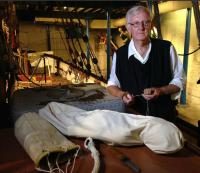
Sail maker Don Lucas at the South Australian Maritime Museum
As part of a new exhibit, Rough Medicine: Life and Death in the Age of Sail, at the South Australia Maritime Museum, sail maker Don Lucas was asked to sew a shroud for a child, actually a child-sized manikin, fortunately, to represent the preparations for a burial at sea. In a recent interview he talked about sewing the shroud:
“I did some research on how those shrouds were sewn at the time and I certainly couldn’t find anything,” Don said. Don believed the task of shroud making would lie in the hands of the ship’s sail maker, being the person most skilled at sewing, but doubted the shrouds would be made of sail canvas.
“When vessels had no other means of propulsion other than sails, one certainly wouldn’t cut a sail into little bits. From the research we have done, we believe it was most probably a bed sheet.”
A bed sheet? Really? With all due respect, I don’t think so. On ships where hammocks were used for sleeping, a dead sailor would traditionally be sewed into his hammock along with weight, often a few round shot, to help the body sink. Captain Frederick Marryat describes a burial at sea in his 1836 book, “Outward Bound Or a Merchant’s Adventures“:
The manner of burial at sea is this. The body is sewn up in the hammock of the dead, and if he died of any disease considered epidemical, the bed clothes are also contained in this canvass shroud. Two or three heavy shot are also sewn up at the feet, to ensure a rapid sinking.
The Royal Navy used eight different weights of canvas for making sails. I am not sure what canvas weight was commonly used for making hammocks. Nevertheless, the canvas used to make hammocks was also used for sail making, so while the sail makers weren’t cutting up sails to make the shrouds, they were using the same material.
Herman Melville dedicates a chapter of his novel “White Jacket” to shroud making with an particular focus on the practice of taking the “last stitch” through the deceased nose when in sewing up the shroud. From Chapter LXXX – “The Last Stitch”:
Just before daybreak, two of the sail-maker’s gang drew near, each with a lantern, carrying some canvas, two large shot, needles, and twine. I knew their errand; for on men-of-war the sail-maker is the undertaker.
They laid the body on deck, and, after fitting the canvas to it, seated themselves, cross-legged like tailors, one on each side, and, with their lanterns before them, went to stitching away, as if mending an old sail.
So clearly, they were making the shroud from ship’s canvas and not bed sheets. More than a century later, that hadn’t changed. James P. Barker writes about the burial of a shipmate on a windjammer in the late 1900s in his 1936 memoir, “The Log of a Limejuicer.” Again, canvas is the material of choice for the shroud.
The sailmaker was turned out and ordered to make a canvas shroud. At midnight, while the Dovenby Hall was headreaching to the west’ard in the teeth of a raging gale, an inert form enshrouded with canvas and weighted at the feet was carried onto the poop deck. The captain mumbled a few words of prayer, and that which had been Lemon Curtis was committed to the depths of the lonely Cape Horn sea.
The problem with bed sheets could well be that there is a good chance that the impact of a full sized corpse hitting the water, weighted down with round shot or steel shackles, would rip the thinner cloth leaving the deceased bobbing along on the surface, which would tend to spoil the moment, I would imagine.
Thanks to Alaric Bond and Irwin Bryan for contributing to this post.

Did any of a ship’s company in the age of sail, excepting officers and passengers, use bed sheets?
I don’t think so. I read recently and I cannot for the life of me recall where about a young sailor comes aboard ship with bed sheets in his sea chest and is the subject of much derision from the rest of the crew. I think it would generally be far more difficult to find bed sheets on a sailing ship than old canvas.
Back then, did they even bother with a shroud?
Especially if you died of some horrible and communicable disease?
They may have wanted to get you overboard ASAP.
Hi Old Salt
I am the curator of the exhibition and we did quite a bit of research into this… including consulting diaries and letters written by 19th century emigrants. While I completely agree with you that hammocks and canvas sails were used in the Navy, on migrant ships there are references to both bed sheets and bread bags being used to bury the dead. Canvas sail cloth was expensive.
I won’t question your research. Canvas was expensive but worn out sail cloth was generally available on sailing ships. I doubt that new canvas would be used as a shroud. If bed sheets were available, no doubt it could have been used. I have never seen any accounts of such, but that may only indicate my lack of scholarship.